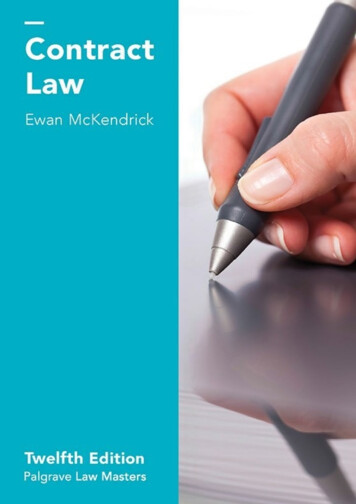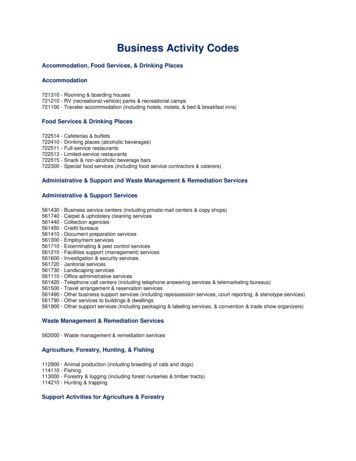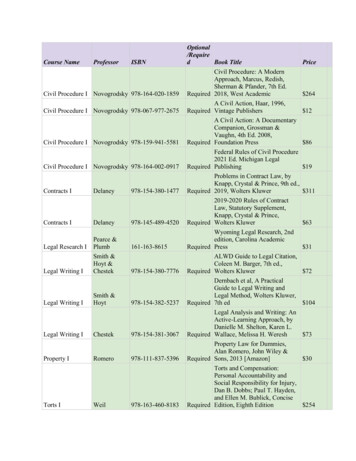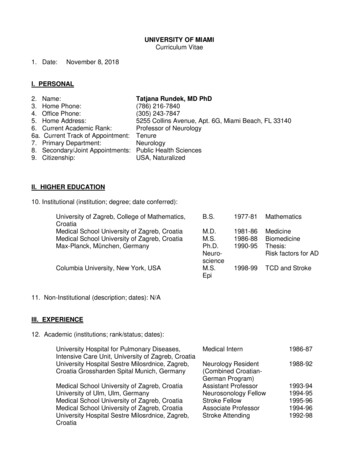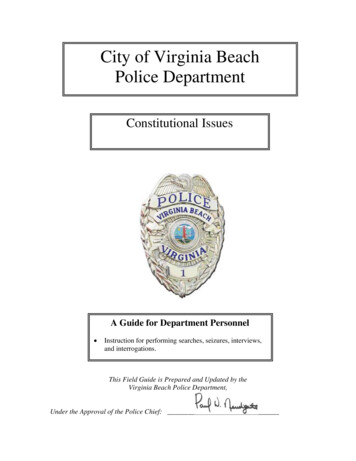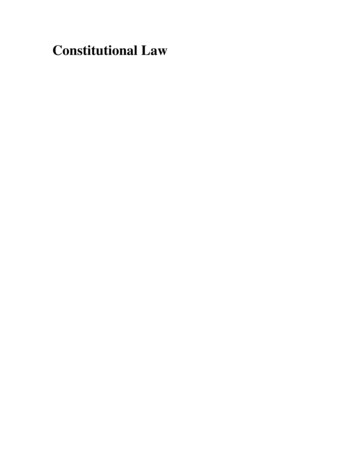
Transcription
Constitutional Law
EDITORIAL ADVISORSRachel E. BarkowSegal Family Professor of Regulatory Law and PolicyFaculty Director, Center on the Administration of Criminal LawNew York University School of LawErwin ChemerinskyDean and Professor of LawUniversity of California, Berkeley School of LawRichard A. EpsteinLaurence A. Tisch Professor of LawNew York University School of LawPeter and Kirsten Bedford Senior FellowThe Hoover InstitutionSenior Lecturer in LawThe University of ChicagoRonald J. GilsonCharles J. Meyers Professor of Law and BusinessStanford UniversityMarc and Eva Stern Professor of Law and BusinessColumbia Law SchoolJames E. KrierEarl Warren DeLano Professor of LawThe University of Michigan Law SchoolTracey L. MearesWalton Hale Hamilton Professor of LawDirector, The Justice CollaboratoryYale Law SchoolRichard K. Neumann, Jr.Professor of LawMaurice A. Deane School of Law at Hofstra UniversityRobert H. SitkoffJohn L. Gray Professor of LawHarvard Law SchoolDavid Alan SklanskyStanley Morrison Professor of LawFaculty Co-Director, Stanford Criminal Justice CenterStanford Law School
Constitutional LawEighth EditionGeoffrey R. StoneEdward H. Levi Distinguished Service Professor of LawUniversity of Chicago Law SchoolLouis Michael SeidmanCarmack Waterhouse Professor of Constitutional LawGeorgetown University Law CenterCass R. SunsteinFelix Frankfurter Professor of LawHarvard Law SchoolMark V. TushnetWilliam Nelson Cromwell Professor of LawHarvard Law SchoolPamela S. KarlanKenneth & Harle Montgomery Professor of Public Interest LawStanford Law School
Copyright 2018 Geoffrey R.Stone; Jessica C. Seidman and Andrew R. Seidman; Cass R.Sunstein; Mark Tushnet; Pamela Karlan; and Rebecca and Laura Tushnet.Published by Wolters Kluwer in New York.Wolters Kluwer Legal & Regulatory U.S. serves customers worldwide with CCH, Aspen Publishers, andKluwer Law International products. (www.WKLegaledu.com)No part of this publication may be reproduced or transmitted in any form or by any means, electronic ormechanical, including photocopy, recording, or utilized by any information storage or retrieval system,without written permission from the publisher. For information about permissions or to request permissionsonline, visit us at www.WKLegaledu.com, or a written request may be faxed to our permissions departmentat 212-771-0803.To contact Customer Service, e-mail customer.service@wolterskluwer.com,call 1-800-234-1660, fax 1-800-901-9075, or mail correspondence to:Wolters KluwerAttn: Order DepartmentPO Box 990Frederick, MD 21705Printed in the United States of America.1234567890ISBN 978-0-7355-0000-0 (USE 13-DIGIT ISBN)CIP tk
About Wolters Kluwer Legal & RegulatoryU.S.Wolters Kluwer Legal & Regulatory U.S. delivers expert content and solutions in the areas of law, corporatecompliance, health compliance, reimbursement, and legal education. Its practical solutions help customerssuccessfully navigate the demands of a changing environment to drive their daily activities, enhance decisionquality and inspire confident outcomes.Serving customers worldwide, its legal and regulatory portfolio includes products under the Aspen Publishers,CCH Incorporated, Kluwer Law International, ftwilliam.com and MediRegs names. They are regarded asexceptional and trusted resources for general legal and practice-specific knowledge, compliance and riskmanagement, dynamic workflow solutions, and expert commentary.
For our families
Summary of ContentsContentsPrefaceAcknowledgmentsEditorial NoticeThe Constitution of the United StatesBiographical Notes on Selected U.S. Supreme Court JusticesThe Supreme Court since 1789IThe Constitution and the Supreme CourtA. Introduction: Creating a Constitution That Binds the FutureB. The Basic FrameworkC. The Sources of Judicial Decisions: Text, “Representation-Reinforcement,” andNatural LawD. Political Control over the Supreme CourtE. “Case or Controversy” Requirements and the Passive VirtuesF. The Jurisdiction of the Supreme CourtII
Federalism at Work: Congress and the National EconomyA. The Values of Federalism and Some Techniques for Implementing ThemB. Doctrinal Fundamentals: Federalism and Judicial ReviewC. The Evolution of Commerce Clause Doctrine: The Lessons (?) of HistoryD. State Regulation of Interstate CommerceE. PreemptionIIIThe Scope of Congress’s Powers: Taxing and Spending, War Powers, IndividualRights, and State AutonomyA. Regulation through Taxing, Spending, and the War PowerB. Congress’s Enforcement Power under the Reconstruction AmendmentsC. The Treaty PowerD. The Tenth Amendment as a Federalism-Based Limitation on Congressional PowerIVThe Distribution of National PowersA. IntroductionB. Case Study: Presidential SeizureC. Foreign AffairsD. Domestic Affairs
VEquality and the ConstitutionA. Slavery, Jim Crow, and the Equal Protection PrincipleB. Equal Protection Methodology: Rational Basis ReviewC. Equal Protection Methodology: Heightened Scrutiny and the Problem of RaceD. Equal Protection Methodology: Heightened Scrutiny and the Problem of GenderE. Equal Protection Methodology: The Problem of Sexual OrientationF. Equal Protection Methodology: Other Candidates for Heightened ScrutinyVIImplied Fundamental RightsA. IntroductionB. The Privileges or Immunities ClauseC. The Due Process Clause and the Incorporation ControversyD. Substantive Due Process: The Protection of Economic Interests and the Question ofRedistributionE. Fundamental Interests and the Equal Protection ClauseF. Modern Substantive Due Process: Privacy, Personhood, and FamilyG. Procedural Due ProcessH. The Contracts and Takings Clauses
VIIFreedom of ExpressionA. IntroductionB. Content-Based Restrictions: Dangerous Ideas and InformationC. Overbreadth, Vagueness, and Prior RestraintD. Content-Based Restrictions: “Low” ValueE. Content-Neutral Restrictions: Limitations on the Means of Communication and theProblem of Content-NeutralityF. Freedom of the PressVIIIThe Constitution and ReligionA. Introduction: Historical and Analytical OverviewB. The Establishment ClauseC. The Free Exercise Clause: Required AccommodationsD. Permissible AccommodationE. Free Exercise, Free Speech, and the Right of Expressive AssociationIXState ActionA. State Action, Federalism, and Individual Autonomy
B. Pure Inaction and the Theory of Governmental NeutralityC. Constitutionally Impermissible Departures from Neutrality: State Subsidization,Approval, and EncouragementD. Constitutionally Required Departures from Neutrality: The Public Function DoctrineE. Unconstitutional Conditions and the Benefit/Burden DistinctionF. Some Final ThoughtsTable of CasesTable of AuthoritiesIndex
ContentsPrefacexxxiiiAcknowledgmentsxxxvEditorial NoticexxxixThe Constitution of the United StatesxliBiographical Notes on Selected U.S. Supreme Court JusticeslviiThe Supreme Court since 1789lxxviiIThe Constitution and the Supreme Court1A. The Origins of the U.S. Constitution71.The Arguments over the New Constitution9The Federalist No. 10 (Madison)11Note: Madisonian Republicanism15The Federalist No. 51 (Madison)18Note: Madisonian Republicanism and Checks and Balances21Note: Madisonian Republicanism and ContemporaryConstitutionalismNote: Why (and How) Does the Constitution Bind?23
B.C.The Basic Framework25Marbury v. Madison25Note: Marbury v. Madison32Martin v. Hunter’s Lessee38Note: Supreme Court Review of State Courts and State Laws42Note: Judicial Exclusivity in Constitutional Interpretation?44The Sources of Judicial Decisions: Text, Original Meaning, Structure,Morality481.482.Text and Original MeaningDistrict of Columbia v. Heller48Note: Text and “Original Public Meaning”52StructureMcCulloch v. Maryland5353Note: Constitutional Methodology and Interpretation inMcCulloch3.Natural Law and Natural Rights6265Calder v. Bull65Note: Natural Law, Moral Argument, and the Supreme Court67D. Political Control over the Supreme CourtNote: Amendment, Appointment, Impeachment, and the Election6970
ReturnsE.Ex parte McCardle75Note: Political Control over Jurisdiction of Article III Courts77Note: The Power of Reprisal—General Thoughts81“Case or Controversy” Requirements and the Passive Virtues821.Advisory Opinions832.Standing85Lujan v. Defenders of Wildlife89Massachusetts v. EPA97Clapper v. Amnesty International USA3.Note: The Law of Standing106Elk Grove Unified School District v. Newdow118Note: Prudential Standing120Political Questions121Baker v. Carr121Note: The Bases for Finding a Political Question126Note: The Development of Standards for Reviewing PoliticalFairness138Vieth v. Jubelirer139
4.F.Bush v. Gore142Note: Political Questions and Partisan Issues149Questions of Timing—Ripeness and MootnessThe Jurisdiction of the Supreme CourtNote: Jurisdiction, Certiorari, and the U.S. Supreme Court153155155IIFederalism at Work: Congress and the National Economy159A. The Values of Federalism and Some Techniques for Implementing Them159Note: A Government of Enumerated Powers159Note: The Values of Federalism161Doctrinal Fundamentals: Federalism and Judicial Review165B.C.Gibbons v. Ogden165Note: Gibbons v. Ogden167Hammer v. Dagenhart (The Child Labor Case)169Wickard v. Filburn171Note: Political Constraints versus Judicial Enforcement172The Evolution of Commerce Clause Doctrine: The Lessons (?) of History179United States v. E. C. Knight Co.180Houston, East & West Texas Railway v. United States (The181
Shreveport Rate Cases)Note: Direct, Indirect, and Stream of Commerce Tests182Champion v. Ames (The Lottery Case)183Note: Prohibiting Interstate Transportation—Proper Regulation orImproper Pretext?185Note: The New Deal Crisis185A. L. A. Schechter Poultry Corp. v. United States186Carter v. Carter Coal Co.188Note: New Deal Legislation and Commerce Clause Tests in the1930s191NLRB v. Jones & Laughlin Steel Corp.193United States v. Darby196Note: The New Deal Legacy198Heart of Atlanta Motel v. United States199Katzenbach v. McClung200Note: Federalism and Congressional Motivation202United States v. Lopez203United States v. Morrison212Note: Federalism after the New Deal214National Federation of Independent Business v. Sebelius218
Note: Activity and Inactivity239Note: Observations on Court-Imposed Limitations on Congress’sPowersD. State Regulation of Interstate Commerce1.2.3.The Fundamental Framework239240240Note: The Classical View240Note: The Modern View242Protection against Discrimination246Note: General Considerations246City of Philadelphia v. New Jersey247Note: Facial/Intentional Discrimination249C & A Carbone, Inc. v. Clarkstown251Note: Geographic Discrimination255West Lynn Creamery, Inc. v. Healy258Note: The Alternative of Subsidies260Note: Other Doctrines Concerning Discrimination260Note: Concluding Observations264Facially Neutral Statutes with Significant Effects on Interstate Commerce264Hunt v. Washington State Apple Advertising Commission266
Note: Inferring Intent from Effect267Exxon Corp. v. Governor of Maryland269Note: Facially Neutral Statutes with (Merely?) DisproportionateEffects for Commercial or Social Purposes272Kassel v. Consolidated Freightways Corp.273Note: Facially Neutral Statutes with (Merely?) DisproportionateE.Effects for Police Power Purposes279Note: Taxation of Interstate Commerce281Preemption283Arizona v. United States283Notes: Preemption288Note: Concluding Observations291IIIThe Scope of Congress’s Powers: Taxing and Spending, War Powers,Individual Rights, and State Autonomy293A. Regulation through Taxing, Spending, and the War Power2941.The Taxing PowerNational Federation of Independent Business v. Sebelius2.The Spending PowerUnited States v. Butler294296301301
3.Note: The Spending Power and the New Deal Court306National Federation of Independent Business v. Sebelius310Note: Conditional Spending, Coercion, and the Political Process320The “War” PowerNote: Individual Rights and the War PowerB.Congress’s Enforcement Power under the Reconstruction Amendments322324325Note: Possible Interpretations of the Section 5 Power326Katzenbach v. Morgan327Note: The Scope of Section 5329City of Boerne v. Flores331Note: The Roles of Court and Congress334Note: The Interaction of Congressional Enforcement Power andthe Eleventh Amendment336Board of Trustees v. Garrett338Note: Congressional Power to Abrogate States’ SovereignImmunity339Note: Congressional Power to Regulate “Private” Action for CivilRights PurposesC.The Treaty PowerMissouri v. Holland344346347
Note: Limits of the Treaty PowerD.348The Tenth Amendment as a Federalism-Based Limitation onCongressional PowerNote: The Modern Revival of Tenth Amendment–BasedRestraints on Federal Regulation of State and Local Governments351Garcia v. San Antonio Metropolitan Transit Authority352Note: From Garcia to New York v. United States353New York v. United States354Printz v. United States356Note: The “Anticommandeering” Principle358Note: Concluding Observations on Congress’s Powers365IVThe Distribution of National Powers367A. Introduction367B.The Federalist No. 47 (Madison)367The Federalist No. 48 (Madison)368Note: The Theory of Separation and Checks and Balances368Case Study: Presidential Seizure370Youngstown Sheet & Tube Co. v. Sawyer (The Steel Seizure Case)370Note: Youngstown and the Power of the President378
Note: The Relevance of Foreign LawC.380Foreign Affairs3821.382Executive AuthorityUnited States v. Curtiss-Wright Corp.382Dames & Moore v. Regan384Medellin v. Texas386Zivotofsky v. KerryNote: The President and Foreign Affairs388Note: The Allocation of Warmaking Authority389Note: The “War on Terror” and the Second Gulf War390Hamdi v. Rumsfeld392Note: The Interplay between the President, Congress, and the2.Court with Regard to the “War on Terror”400Note: Some Unanswered Questions403Legislative AuthorityNote: The War Powers Resolution406406Note: Congressional Control over Agreements with ForeignStates—Treaties, Executive Agreements, and CongressionalExecutive AgreementsD. Domestic Affairs409411
1.2.Executive Authority411United States v. Nixon412Note: Executive Privilege and Presidential Immunity416Note: The Politics of Impeachment420Note: The “Law” of Impeachment421Legislative Authority424Note: The Nondelegation Doctrine and “Quasi-Constitutional”Statutes424INS v. Chadha429Note: The Legislative Veto434Note: Where Do Administrative Agencies “Fit” in the Separationof Powers Scheme?435Bowsher v. Synar439Morrison v. Olson441Note: Congressional Control over Administrative Officials448Note: Distribution of National Powers—Final Thoughts451VEquality and the Constitution453A. Slavery, Jim Crow, and the Equal Protection Principle4531.Slavery and the Constitution454
2.3.4.State v. Post455Note: The Constitutionality of Slavery457Dred Scott v. Sandford459Note: Dred Scott and the Power of Judicial Review461Reconstruction and Retreat463Note: The Work of the Reconstruction Congress463Note: The Judicial Reaction465Plessy v. Ferguson468Note: Separate but Equal471The Attack on Jim Crow472Note: The Road to Brown473Brown v. Board of Education of Topeka (Brown I)476Note: Justifications and Explanations for Brown478Brown v. Board of Education of Topeka (Brown II)482Note: “All Deliberate Speed”484The Meaning of BrownNote: The Initial Response to Brown485485Note: The De Jure/De Facto Distinction and Limits on Courts’Remedial Powers489
B.C.Equal Protection Methodology: Rational Basis Review497New York City Transit Authority v. Beazer498Note: Equal Treatment and Relevant Differences501Note: Limitations on Permissible Government Purposes503U.S. Department of Agriculture v. Moreno504City of Cleburne v. Cleburne Living Center505Romer v. Evans506Note: “Actual Purpose” Review508Minnesota v. Clover Leaf Creamery Co.509Note: The Means-Ends Nexus513Railway Express Agency v. New York516Williamson v. Lee Optical517Equal Protection Methodology: Heightened Scrutiny and the Problem of Race1.520The Origins and Rationale for Heightened Scrutiny in Race-SpecificClassifications That Disadvantage Racial Minorities521Strauder v. West Virginia521Korematsu v. United States523Loving v. Virginia527Note: Doctrinal Evolution in the Scrutiny Applied to RacialClassifications528
2.Note: Justifications for Strict Scrutiny of Racial Classifications530Note: The Structure of Strict Scrutiny535Facially Nonracial Classifications That Disadvantage Racial Minorities:When Does Heightened Scrutiny Apply?Washington v. Davis540540Note: Rational Basis Review of Non–Race-SpecificClassifications542Note: What Constitutes a Racially Motivated Classification?:Questions of Discriminatory Purpose544Note: Distinctive Problems in the Administration of CriminalJustice551McCleskey v. Kemp554Note: Racial Disparities in Investigating, Charging, andSentencing3.Race-Specific Classifications Designed to Benefit Racial Minorities559562Note: The Imposition of Strict Scrutiny562Adarand Constructors, Inc. v. Pena567Note: The Constitutionality of “Benign” Racial Classifications574Grutter v. Bollinger580Note: The Contemporary Application of Strict Scrutiny591Gratz v. Bollinger595
Note: Scrutiny of MeansFisher v. University of Texas (Fisher II)Note: The Special Problem of Facially Neutral but Race-Specific4.Voting Districts599Note: The “Special” Case of Indigenous People605Note: A Comparative Perspective606The Synthesis of Brown and Affirmative Action608Parents Involved in Community Schools v. Seattle School DistrictNo. 1608Note: Parents Involved and the Synthesis of Equal ProtectionLaw624D. Equal Protection Methodology: Heightened Scrutiny and the Problem ofGender6291.The Early Cases6292.The Road to Intermediate Scrutiny631Reed v. Reed631Frontiero v. Richardson631Note: From Reed to Craig v. Boren—Evolution and DoctrinalConfusion633Craig v. Boren637Note: Heightened Scrutiny for Gender Classifications?642
3.Archaic and Overbroad Generalizations versus “Real” Differences647United States v. Virginia647Note: “Real Differences” and Formal Equality654Nguyen v. Immigration & Naturalization ServiceE.F.Sessions v. Morales-Santana658Note: The Relevance of “Real Differences”662Note: Gender Discrimination as a Two-Edged Sword666Note: The Problem of “Benign” Gender Classifications670Note: Sex Discrimination Law and Constitutional Evolution671Equal Protection Methodology: The Problem of Sexual Orientation673Note: The Nature of the Class at Issue673Romer v. Evans675Note: The Meaning of Romer683Note: The Standard of Review685Equal Protection Methodology: Other Candidates for Heightened Scrutiny6961.696AlienageSugarman v. Dougall697Note: Strict Scrutiny for Classifications Based on Alienage—Defining the Political Community700
Note: Alienage and Federal Preemption2.Wealth ClassificationsNote: Defining the Class703707707Note: Wealth Discrimination and the Problem of AffirmativeRights3.Other Disadvantaged Groups709714City of Cleburne v. Cleburne Living Center714Note: Evaluating the Claims of Other Disadvantaged Groups716VIImplied Fundamental Rights721A. Introduction721Note: Theories of Constitutional Interpretation—“Originalism”and Its CriticsB.C.The Privileges or Immunities Clause722729The Slaughter-House Cases730Note: The Demise of the Privileges or Immunities Clause735The Due Process Clause and the Incorporation Controversy739Note: Due Process and Incorporation739McDonald v. City of Chicago741D. Substantive Due Process: The Protection of Economic Interests and the750
Question of RedistributionE.Note: The Road to Lochner750Lochner v. New York753Note: The (Alleged?) Vices of Lochner758Note: The Lochner Era, 1905–1934764Nebbia v. New York766West Coast Hotel Co. v. Parrish767Note: The End of an Era769United States v. Carolene Products Co.770Williamson v. Lee Optical of Oklahoma771Ferguson v. Skrupa772Note: Pluralism, Naked Wealth Transfers, and the Courts773Fundamental Interests and the Equal Protection Clause1.Skinner v. Oklahoma776Note: The Fundamental “Right to Have Offspring”778Votinga.776780Denial of the “Right to Vote”780Harper v. Virginia State Board of Elections781Note: Is the Right to Vote “Fundamental”?782
b.c.2.3.Kramer v. Union Free School District784Note: Kramer and Its Progeny785Dilution of the “Right to Vote”788Reynolds v. Sims789Note: Reynolds and Its Progeny792City of Mobile v. Bolden795Note: Vote Dilution and the Interests of Groups799Denial of “Access to the Ballot”803Williams v. Rhodes803Note: Williams and Its Progeny804Access to the Judicial Process807Griffin v. Illinois807Douglas v. California807Note: Fundamental Interests and the Criminal Justice System808Boddie v. Connecticut812Note: Access to the Judicial Process in Civil Cases813Travel814Shapiro v. Thompson814Saenz v. Roe818
4.5.F.Note: The Right to Travel as a “Fundamental Interest”819Note: “Penalizing” the Right to Travel820Welfare824Dandridge v. Williams825Note: Dandridge and the Judicial Role in the Welfare Context826Education828San Antonio Independent School District v. Rodriguez828Note: The Rodriguez Formulation834Plyler v. Doe835Note: Plyler and the Equal Protection Clause840Modern Substantive Due Process: Privacy, Personhood, and Family8411.8422.The Right of PrivacyGriswold v. Connecticut842Note: Griswold and the Right of Privacy850Abortion854Roe v. Wade854Note: The Abortion Decision859Note: Abortion Regulation between Roe and Casey870Planned Parenthood of Southeastern Pennsylvania v. Casey873
Note: Casey and the Role of the Court892Gonzales v. Carhart893Hellerstedt v. Whole Woman’s HealthNote: The Future of Abortion Rights3.907Same-Sex IntimacyLawrence v. TexasNote:The Legal and Political Landscape on the Eve of ObergefellObergefell v. Hodges909Note: A Right to Same-Sex Marriage4.Other Family and Privacy InterestsMoore v. City of East Cleveland909Note: Nontraditional Association5.The Right to DieCruzan v. Director, Missouri Department of Health937Washington v. Glucksberg944Note: The Right to Die951G. Procedural Due Process1.937Liberty and Property InterestsBoard of Regents of State Colleges v. Roth953953954
2.Perry v. Sindermann955Cleveland Board of Education v. Loudermill956Note: Defining “Liberty” and “Property”958Note: Statutory Entitlements, Property, and Natural Liberty959What Process Is DueMathews v. Eldridge962Note: Balancing Tests and the Due Process Clause966Note: Procedural Due Process and “Legislative” Determinations972H. The Contracts and Takings Clauses1.962The Contracts Clause973973Note: Early Interpretive Problems973Home Building & Loan Association v. Blaisdell976Note: Market Ordering and Constitutional Interpretation979United States Trust Co. v. New Jersey980Allied Structural Steel Co. v. Spannaus982Note: United States Trust, Spannaus, and the Nonrevival of theContracts Clause2.The Eminent Domain ClauseKelo v. City of New London984986986
Note: The Public Use Requirement and the Takings Clause988Pennsylvania Coal Co. v. Mahon991Miller v. Schoene993Penn Central Transportation Co. v. New York City995Keystone Bituminous Coal Association v. DeBenedictis1000Note: “Takings” and the Police Power1001Nollan v. California Coastal Commission1008Note: Nollan, Unconstitutional Conditions, and Other Problems1010Lucas v. South Carolina Coastal Council1013Note: Lucas, the Environment, and Regulatory Takings1020Palazzolo v. Rhode Island1022Note: Palazzolo—Final Thoughts1026VIIFreedom of Expression1027A. Introduction1027B.Note: The History of Free Expression1027Note: The Philosophy of Free Expression1032Note: Organization1037Content-Based Restrictions: Dangerous Ideas and Information1038
1.Speech That “Causes” Unlawful Conduct1038Shaffer v. United States1039Masses Publishing Co. v. Patten1040Schenck v. United States1043Note: Shaffer, Masses, and Schenck1044Frohwerk v. United States1047Debs v. United States1047Abrams v. United States1048Note: Abrams and the Emergence of the Holmes-BrandeisTradition1051Gitlow v. New York1053Note: “Abstract Doctrine” versus “Urging to Action”1056Whitney v. California1057Note: The Brandeis Concurrence and the Road to Dennis1060Dennis v. United States1062Note: Dennis and the Communist “Conspiracy”1067Note: The Road to Brandenburg1070Brandenburg v. Ohio1072Note: The Brandenburg Formulation1074
Note: Abridgment of Speech Other Than by Direct CriminalProhibition2.3.Speech That Provokes a Hostile Audience Reaction10781083Terminiello v. Chicago1083Cantwell v. Connecticut1084Feiner v. New York1085Note: The Search for Mechanisms of Control1088Chaplinsky v. New Hampshire1091Note: Fighting Words1093Note: The Skokie Controversy1096Snyder v. Phelps1098Classified Information1100New York Times Co. v. United States; United States v.C.Washington Post Co.1100Note: The Pentagon Papers Controversy1108Note: Dangerous Ideas and Information—Final Thoughts1115Overbreadth, Vagueness, and Prior Restraint11161.1116Overbreadth and VaguenessGooding v. Wilson1116Note: Overbreadth1119
Note: Vagueness2.Prior Restraint2.1124Lovell v. Griffin1125Note: Licensing as Prior Restraint1126Near v. Minnesota1129Note: Injunction as Prior Restraint1131D. Content-Based Restrictions: “Low” Value1.1122False Statements of Fact11341135New York Times v. Sullivan1135Note: “The Central Meaning” of New York Times v. Sullivan1140Curtis Publishing Co. v. Butts; Associated Press v. Walker1143Gertz v. Robert Welch, Inc.1144Note: Public and Private Figures, Public and Private Speech1146Dun & Bradstreet v. Greenmoss Builders1148Note: Other False Statements of Fact1148United States v. Alvarez1149Hustler Magazine v. Falwell1153“Nonnewsworthy” Disclosures of “Private” InformationCox Broadcasting Corp. v. Cohn11551155
Note: Invasion of Privacy and the First Amendment3.4.Threats11581161Bridges v. California1161Watts v. United States1162Planned Parenthood v. American Coalition of Life Activists1163Commercial Advertising1165Virginia State Board of Pharmacy v. Virginia Citizens ConsumerCouncil1166Note: Virginia Pharmacy and the “Free Flow of CommercialInformation”1172Note: Truthful, Nondeceptive Commercial Advertising after5.Virginia Pharmacy1174Central Hudson Gas v. Public Service Commission of New York1175Note: Truthful, Nondeceptive Commercial Advertising1176Note: Other Regulations of Commercial Advertising1180Obscenity1183Roth v. United States; Alberts v. California1184Note: Obscenity and Free Expression1185Note: Developments in the Law of “Obscenity”—1957–19731189Miller v. California1192
6.7.Paris Adult Theatre I v. Slaton1195Note: The 1973 Reformulation and Its Aftermath1198Child Pornography, Animal Cruelty, and Violent Expression1201New York v. Ferber1201Ashcroft v. The Free Speech Coalition1203Note: Child Pornography1206United States v. Stevens1208Brown v. Entertainment Merchants Association1211The Lewd, the Profane, and the Indecent1214Cohen v. California1215Note: Profanity, Cohen, and the Captive Audience1218Erznoznik v. Jacksonville1221FCC v. Pacifica Foundation1222Note: Fleeting Expletives1224Sable Communications, Inc. v. FCC1225Reno v. American Civil Liberties Union1226Ashcroft v. American Civil Liberties Union1227Note: “Indecent” Expression1229Note: Zoning Theaters with Adult Movies and Bars with Nude1232
Dancing8.E.Hate Speech and Pornography1236Beauharnais v. Illinois1236Note: Group Defamation and “Hate Speech”1239R.A.V. v. City of St. Paul1243Wisconsin v. Mitchell1248Note: R.A.V. and Mitchell1248Virginia v. Black1251Note: R.A.V. and Black1258Note: Pornography and the Victimization of Women1259Note: “Low”-Value Speech—Final Thoughts1262Content-Neutral Restrictions: Limitations on the Means of Communicationand the Problem of Content-Neutrality12631.1264General PrinciplesSchneider v. State1264Martin v. City of Struthers1265Kovacs v. Cooper1266Metromedia, Inc. v. San Diego1266City of Ladue v. Gilleo1267
2.Bartnicki v. Vopper1268Note: The Search for Principles1270Note: The Meaning of “Content-Neutrality”1271Speech on Public Property: The Public Forum1274a.The Public Forum: Streets and Parks1275Commonwealth v. Davis1275Hague v. CIO1276Schneider v. State1277Note: Regulating the Public Forum1278Note: Devices for Regulating the Public Forum1282The Public Forum: Other Publicly Owned Property1285Adderley v. Florida1285Note: “No Less Than a Private Owner of Property”?1287International Society for Krishna Consciousness v. Lee1291Note: Modern Public Forum Doctrine1293Note: The Right to a “Private” Forum1294b.c.The Public Forum: Unequal Access and the Problem of ContentNeutrality1296Police Department of Chicago v. Mosley1296
Note: Mosley and the “Equality” of Ideas1298Lehman v. City of Shaker Heights1300Note: Lehman and the Limits of Mosley1304Perry Educators’ Association v. Perry Local Educators’Association1305Note: Quintessential, Designated, and Nonpublic Forums1307Note: Religious Expression and the Meaning of “ViewpointNeutrality”1311Christian Legal Society Chapter v. Martinez1314Reed v. Town of Gilbertd.Unequal Access and the Problem of Government Speech1317Southeastern Promotions v. Conrad1317Board of Education, Island Trees Union Free School District v.Pico1319Regan v. Taxation with Representation of Washington1321National Endowment for the Arts v. FinleyRust v. Sullivan1322Note: The Implications of Rust1324Legal Services Corp. v. Velazquez1329Agency for International Development v. Alliance for Open
Society InternationalNote: The Reach of Government Speech: Summum, Walker, andMatal3.5.Symbolic Conduct13321337United States v. O’Brien1338Note: Draft Card Burning and the First Amendment1342Note: Flag Desecration and Misuse1348Barnes v. Glen Theatre, Inc.1353City of Erie v. Pap’s A.M.1355Note: Other Forms of Symbolic Speech1357Regulation of Political Solicitation, Contribution, Expenditure, andActivityBuckley v. Valeo13591359Note: Buckley and the Problem of Abridging Speech to“Enhance” the Electoral Process1367Note: Subsidy and Disclosure1370Note: Campaign Finance Regulation in the Thirty Years AfterBuckleyMcConnell v. Federal Election Commission1375Note: Campaign Finance and the Roberts CourtCitizens United v. Federal Elections Commission1385 p
Erwin Chemerinsky Dean and Professor of Law University of California, Berkeley School of Law Richard A. Epstein Laurence A. Tisch Professor of Law . Constitutional Law Eighth Edition Geoffrey R.
